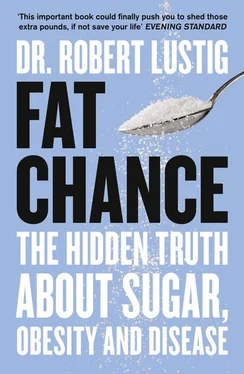The overriding thesis of this book is that your fat is not your fate – provided you don’t surrender. Because people don’t die of obesity per se. They die of what happens to their organs. On the death certificate, the medical examiner doesn’t write down “obesity”; instead it’s “heart attack,” “heart failure,” “stroke,” “diabetes,” “cancer,” “dementia,” or “cirrhosis of the liver.” These are diseases that “travel” with obesity. They are all chronic metabolic diseases. But normal-weight people die of these as well. That’s the point. It’s not the obesity. The obesity is not the cause of chronic metabolic disease. It’s a marker of chronic metabolic disease, otherwise known as metabolic syndrome. And it’s metabolic syndrome that will kill you. Understanding this distinction is crucial to improving your health, no matter your size. Obesity and metabolic syndrome overlap, but they are different. Obesity doesn’t kill. Metabolic syndrome kills. Although they travel together, one doesn’t cause the other. But then, what causes obesity? And what causes metabolic syndrome? And what can you do about each? Read on.
I wrote this book to help you and your kids get healthy and improve your quality of life, increase your productivity, and reduce the world’s waste of medical resources. If you get thin in the process, great. But if that’s what you expect, go find your own diet guru, and good luck with that. Want to get healthier? Want to get happier? Want to get smarter? It’s your visceral (around your abdominal organs) fat and hepatic (liver) fat that’s keeping you down. And getting rid of visceral fat is not as hard as you might think. This is the more metabolically active fat, and there’s plenty you can do to shrink it.
A proverb says, “A journey of a thousand miles begins with a single step.” This book is a journey into the workings of the body. It is a journey into the biochemistry of our brains and our fat cells. It is a journey into evolution, the mismatch between our environment and our biochemistry. And it is a journey into the world of business and politics, too. This journey starts with a single but very large step, in which we abandon our current thinking of obesity by challenging the age-old dogma “ a calorie is a calorie .”
Chapter 2
A Calorie Is a Calorie – or Is It?
“If folks want to maintain a healthy weight, they have to be sensitive to the calories in and calories out…Not every calorie is the same.”
Governor Tom Vilsack (D-Iowa), U.S. Secretary of Agriculture, upon release of the 2010 Dietary Guidelines, January 13, 2011
Wait a second. If people have to be sensitive to calories in and out, then why aren’t calories the same? Does anyone see the contradiction here? This was the first time that any government official had even remotely hinted that calories might not be interchangeable, and it was buried in this cryptic double-speak.
Everyone is a dietitian. Everyone thinks he or she understands obesity. Believe it or not, this is one of the harder medical conditions to comprehend. Why? Obesity is a combination of several factors: physics, biochemistry, endocrinology, neuroscience, psychology, sociology, and environmental health, all rolled up into one problem. The factors that drive the obesity pandemic are almost as myriad as the number of people who suffer from it.
The Venus Von Willendorf is an eleven-inch statue carbon-dated to 22,000 BCE that was unearthed in Austria in 1908 (see figure 2.1). It depicts the torso of a morbidly obese adult woman. This shows us that the ancients knew about obesity long before they knew about fast food. There are other ways to gain weight aside from potato chips and pizza, soda and suds. The medical literature lists at least thirty diagnoses that include obesity as a symptom. These include problems of the brain, liver, and adipose (fat) tissue; genetic disorders; various hormonal imbalances; and the effects of certain medications.
But none of these medical causes explain what’s happened to the world’s population over the last thirty years. Until 1980, statistically only 15 percent of the adult population had a body mass index – or BMI, an indicator of body fatness that is calculated from a person’s weight and height – above the eighty-fifth percentile, indicating either overweight or obesity. Now that statistic is 55 percent. And by 2030 it’s expected to be 65 percent. [8] S. L. Gortmaker et al., “Changing the Future of Obesity: Science, Policy, and Action,” Lancet 378 (2011) 838–47.
Something’s happened in the last thirty years, but what?

Fig. 2.1. A Venus FatTrap.The Venus von Willendorf is an 11-cm-high statuette of a female that carbon-dates to between 24,000 and 22,000 BCE. It was discovered in 1908 in Austria, and is on display in the Naturhistorisches Museum in Vienna. It shows that obesity is as old as man (or woman) himself.
The First Law
In order to understand obesity, and energy balance in general, we must acquaint ourselves with the first law of thermodynamics, which states, “The total energy inside a closed system remains constant.” For you math and science geeks:
U = Q – W
where U is the internal energy of a system, Q is the heat supplied by the system, and W is the work done by the system. Work and heat are due to processes that either add or subtract energy; when work = heat, the internal energy stays constant. The first law is a law . It is elegant and airtight. If you don’t like it, file a grievance with Sir Isaac Newton. I subscribe to the first law. The basis for our current understanding of the causes and consequences of the obesity pandemic lies not with the first law itself, but rather in how you interpret it, for, as with all laws, there is plenty of room for alternative interpretations.
The prevailing wisdom on the first law can be summed up by one widely held dogma: a calorie is a calorie . That is, to maintain energy balance and body weight (the U in the equation), one calorie eaten (the Q) must be offset by one calorie burned (the W). The calorie eaten can come from anywhere, from meat to vegetables to cheesecake. The calorie burned can go to anywhere, from sleeping to watching TV to vigorous exercise. And from this dogma comes the standard and widely held interpretation of the first law: “If you eat it, you had better burn it, or you will store it.” In this interpretation, the behaviors of increased energy intake and decreased energy expenditure are primary (and presumably learned); therefore, the weight gained is a secondary result. Thus, obesity is routinely thought to be the natural consequence of these “aberrant behaviors.” As you will see hereafter, virtually all the stakeholders in the obesity pandemic have signed up on the side of personal responsibility.
The Seating Chart at the Table of Blame
The Head of the Table: The Gluttons and the Sloths
Personal responsibility occupies the biggest seat at the Table of Blame. The common assumption in obesity hinges on its being a personal choice: We control what we eat and how much we exercise. If you are obese, it must be because you chose to either eat more, exercise less, or both. Over the past twenty-five years, various government agencies have accumulated ample evidence of the increased caloric intake during that time frame, both in children and in adults. During this time, the CDC has documented that Americans have increased their caloric consumption by an extra 187 calories per day for men, 335 calories per day for women. The behaviors associated with the rise in obesity include increased consumption of sugar-sweetened beverages and decreased consumption of whole fruits, vegetables, and other sources of dietary fiber. On a societal level, obesity is also associated with less breastfeeding, skipped breakfasts, fewer family meals, and more fast food dining. Alternatively, a wealth of evidence supports a role for decreased physical activity and increased “screen time” (TV, computers, video games, and texting) in causing obesity.
Читать дальше













